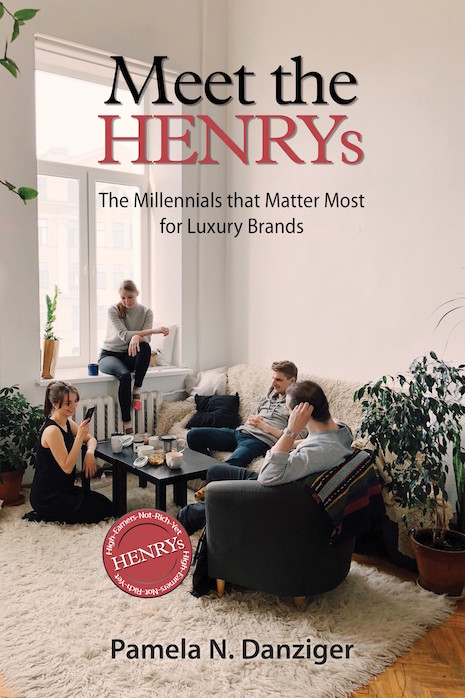 Millennials are critical to luxury brands' future. Image credit: “Meet the HENRYs: The Millennials that Matter Most for Luxury Brands” (Paramount Book Publishing, 2019)
Millennials are critical to luxury brands' future. Image credit: “Meet the HENRYs: The Millennials that Matter Most for Luxury Brands” (Paramount Book Publishing, 2019)
By Pamela N. Danziger The millennial High-Earners-Not-Rich-Yet (HENRY) consumers are the next-generation customers that every luxury brand manager, marketer and retail executive needs to know and know well. Below is an excerpt from the latest treatise on them: Pamela N. Danziger’s new book, “Meet the HENRYs: The Millennials that Matter Most for Luxury Brands” (Paramount Market Publishing, January 2019, pp 272). Reproduced with permission.
How to Be a Brand HENRYs Will Love – Tell New Stories of Luxury For young HENRYs, who will become the next generation of luxury consumers, the goal of making more money, getting promoted, or becoming a partner is all well and good, but the traditional accomplishments are not the only prize they are after. Rather, it’s the accomplishment of achieving a personal goal and digging deep to succeed at something truly remarkable, like completing an Ironman triathlon or doctoral dissertation. These smart, accomplished young people know that just about anybody can make a lot of money, if that is what one aims for. But HENRYs measure their success in ways more personally meaningful than just financial success. That’s why for many HENRYs luxury-brand watches have lost much of their status symbol cachet, since owning one mainly communicates financial status, i.e. how much money one makes and spends. Rather, HENRYs are looking for brands that communicate something more meaningful than just their net worth. For young HENRY affluents, there is a distinct generational component to their chosen status symbols. They reject their parent’s or grandparent’s status symbols, in favor of symbols that communicate to their peers which ‘tribe’ they belong. So HENRYs’ status symbols are less about traditional high-end luxury brands and more about brands that really express one’s values and identity. Think a Mini Cooper, rather than a Mercedes; or a Filson messenger bag, rather than one by Louis Vuitton; or a Shinola Runwell watch, instead of a Rolex. That said, the TAG Heuer watch brand, after an unsuccessful attempt by corporate parent LVMH to move the brand upmarket to compete in the luxury price range of $5,000-$10,000, has recently reversed course, and brought the core of the product line back to a more affordable $1,000-$5,000 price point with new positioning aimed at the spirit and mindset of the HENRYs. Getting to the “why” of the brand is where the future of the luxury market will be built Even at $2,000, a TAG Heuer watch is still quite luxurious, but the new branding tagline, “Don’t Crack Under Pressure,” and its alignment with youth-skewing celebrity icons, like Super-Bowl champ Tom Brady, super-model Cara Delevingne and tennis star Maria Sharapova, are intended to resonate with HENRYs. TAG Heuer also recognizes that today’s HENRY women, as well as men, appreciate the high-performance promise that is a foundation of the brand. In looking to the brand’s future, it has just introduced the Connected smartwatch to compete with Apple, priced at a very competitive $1,500, designed and built with Intel and Google under the Android Wear operating system. Yet at the same time, TAG hasn’t abandoned its legendary past and continues to offer its classic Steve McQueen line, in honor of a man who having never grown old, remains an icon for young HENRYs. In a recent talk at the Hackers on the Runway conference in Paris organized by TheFamily, marketer-extraordinaire Seth Godin asked “Is Digital the End of Luxury Brands?” Rather, the question should be “Is the Digital Generation, i.e. young HENRYs, the End of Luxury Brands?” The key challenge for luxury brands with the young HENRYs is not about how they connect – Internet marketing tactics – but how to create new and compelling reasons why their brands are meaningful and important to this digitally empowered generation. Getting to the “why” of the brand is where the future of the luxury market will be built. New branding strategies are what’s needed, not just creative programming or digital-marketing tactics. It is all about tailoring the brand message to the unique psychology of younger consumers on the road to affluence.
 “Meet the HENRYs: The Millennials that Matter Most for Luxury Brands” (Paramount Book Publishing, 2019)
“Meet the HENRYs: The Millennials that Matter Most for Luxury Brands” (Paramount Book Publishing, 2019)
- Luxury of Performance – Luxury can’t just exist as a product concept anymore, it has to deliver an experience that is meaningful to young HENRYs. It has to perform. Brands have to deliver some meaningful, measurable value to the HENRY customer. Performance and function is a key differentiator. Performance takes brands out of the realm of simply being to actually doing something important for the customer. Performance luxury is exemplified by brands like Canada Goose, a brand that has been around more than 50 years as the “performance” brand for lumber jacks and polar adventurers. But Canada Goose shed its macho image on the cover of Sports Illustrated with supermodel Kate Upton wearing little more than a $595 Chilliwack Bomber jacket on a ship in Antarctic waters.
- Luxury of Simplicity – Personal care and beauty brand Kiehl’s sells simplicity itself – simple product, simple ingredients, simple packaging – and extraordinary results. Its prominent “Since 1851” heritage says a brand that has been around that long must be doing it right. Kiehl’s simplifies its packaging and presentation elegantly. Simplicity is hard to do, but beautiful to behold when it is achieved. “Less is more” becomes the guide to creating simple, elegant brands and brand stories.
- Anti-Status Luxury – As a brand, Jeep defines its promise as “Vehicles enabling life’s extraordinary journeys.” It explains its goal to: “Provide vehicles that support a lifestyle of boundless freedom, responsible adventure, and are reliable, safe, fun and environmentally friendly.” Jeep is an experiential brand that most especially promises to take its owners outdoors, as well as to the grocery store or mall.
 Pam Danziger is president of Unity Marketing
Pam Danziger is president of Unity Marketing
